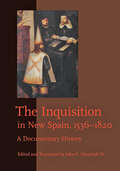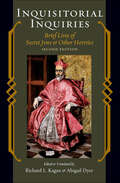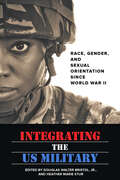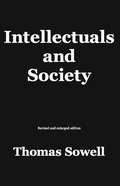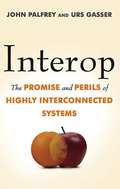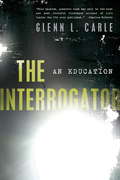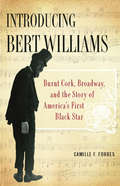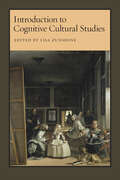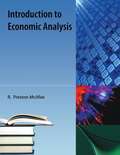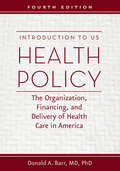- Table View
- List View
The Inquisition in New Spain, 1536–1820: A Documentary History
by John F. ChuchiakThe Inquisition! Just the word itself evokes, to the modern reader, endless images of torment, violence, corruption, and intolerance committed in the name of Catholic orthodoxy and societal conformity. But what do most people actually know about the Inquisition, its ministers, its procedures? This systematic, comprehensive look at one of the most important Inquisition tribunals in the New World reveals a surprisingly diverse panorama of actors, events, and ideas that came into contact and conflict in the central arena of religious faith.Edited and annotated by John F. Chuchiak IV, this collection of previously untranslated and unpublished documents from the Holy Office of the Inquisition in New Spain provides a clear understanding of how the Inquisition originated, evolved, and functioned in the colonial Spanish territories of Mexico and northern Central America. The three sections of documents lay out the laws and regulations of the Inquisition, follow examples of its day-to-day operations and procedures, and detail select trial proceedings. Chuchiak’s opening chapter and brief section introductions provide the social, historical, political, and religious background necessary to comprehend the complex and generally misunderstood institutions of the Inquisition and the effect it has had on societal development in modern-day Mexico, Guatemala, El Salvador, Nicaragua, and Honduras. Featuring fifty-eight newly translated documents, meticulous annotations, and trenchant contextual analysis, this documentary history is an indispensable resource for anyone seeking to understand the Inquisition in general and its nearly three-hundred-year reign in the New World in particular.
The Inquisition in New Spain, 1536–1820: A Documentary History
by John F. Chuchiak IVThe Inquisition! Just the word itself evokes, to the modern reader, endless images of torment, violence, corruption, and intolerance committed in the name of Catholic orthodoxy and societal conformity. But what do most people actually know about the Inquisition, its ministers, its procedures? This systematic, comprehensive look at one of the most important Inquisition tribunals in the New World reveals a surprisingly diverse panorama of actors, events, and ideas that came into contact and conflict in the central arena of religious faith.Edited and annotated by John F. Chuchiak IV, this collection of previously untranslated and unpublished documents from the Holy Office of the Inquisition in New Spain provides a clear understanding of how the Inquisition originated, evolved, and functioned in the colonial Spanish territories of Mexico and northern Central America. The three sections of documents lay out the laws and regulations of the Inquisition, follow examples of its day-to-day operations and procedures, and detail select trial proceedings. Chuchiak’s opening chapter and brief section introductions provide the social, historical, political, and religious background necessary to comprehend the complex and generally misunderstood institutions of the Inquisition and the effect it has had on societal development in modern-day Mexico, Guatemala, El Salvador, Nicaragua, and Honduras. Featuring fifty-eight newly translated documents, meticulous annotations, and trenchant contextual analysis, this documentary history is an indispensable resource for anyone seeking to understand the Inquisition in general and its nearly three-hundred-year reign in the New World in particular.
Inquisitorial Inquiries: Brief Lives of Secret Jews and Other Heretics
by Richard L. Kagan Abigail DyerOn the first day of Francisco de San Antonio's trial before the Spanish Inquisition in Toledo in 1625, his interrogators asked him about his parentage. His real name, he stated, was Abram Rubén, and he had been born in Fez of Jewish parents. How then, Inquisitors wanted to know, had he become a Christian convert? Why had a Hebrew alphabet been found in his possession? And what was his business at the Court in Madrid? "He was asked," according to his dossier, "for the story of his life." His response, more than ten folios long, is one of the many involuntary autobiographies created by the logic of the Inquisition that today provide rich insights into both the personal lives of the persecuted and the social, cultural, and political realities of the age.In the first edition of Inquisitorial Inquiries, Richard L. Kagan and Abigail Dyer collected, translated, and annotated six of these autobiographies from a diverse group of prisoners. Now they add the fascinating life story of another victim of the Inquisition: Esteban Jamete, a French sculptor accused of being a Protestant. Each of the autobiographies has been selected to represent a particular political or social issue, while at the same time raising more intimate questions about the religious, sexual, political, or national identities of the prisoners. Among them are a politically incendiary prophet, a self-proclaimed hermaphrodite, and a morisco, an Islamic convert to Catholicism.
Integrating the US Military: Race, Gender, and Sexual Orientation since World War II
by Douglas W. Bristol Jr. Heather Marie SturOne of the great ironies of American history since World War II is that the military;¢;‚¬;€?typically a conservative institution;¢;‚¬;€?has often been at the forefront of civil rights. In the 1940s, the 1970s, and the early 2000s, military integration and promotion policies were in many ways more progressive than similar efforts in the civilian world. Today, the military is one of the best ways for people from marginalized groups to succeed based solely on job performance.Integrating the US Military traces the experiences of African Americans, Japanese Americans, women, and gay men and lesbians in the armed forces since World War II. By examining controversies from racial integration to the dismantling of "Don;€™t Ask, Don;€™t Tell" to the recent repeal of the ban on women in combat, these essays show that the military is an important institution in which social change is confirmed and, occasionally, accelerated. Remarkably, the challenges launched against the racial, gender, and sexual status quo in the postwar years have also broadly transformed overarching ideas about power, citizenship, and America;€™s role in the world.The first comparative study of legally marginalized groups within the armed services, Integrating the US Military is a unique look at the history of military integration in theory and in practice. The book underscores the complicated struggle that accompanied integration and sheds new light on a broad range of comparable issues that affect civilian society, including affirmative action, marriage laws, and sexual harassment.
Integrating the US Military: Race, Gender, and Sexual Orientation since World War II
by Douglas W. Bristol Jr. Heather Marie SturOne of the great ironies of American history since World War II is that the military;¢;‚¬;€?typically a conservative institution;¢;‚¬;€?has often been at the forefront of civil rights. In the 1940s, the 1970s, and the early 2000s, military integration and promotion policies were in many ways more progressive than similar efforts in the civilian world. Today, the military is one of the best ways for people from marginalized groups to succeed based solely on job performance.Integrating the US Military traces the experiences of African Americans, Japanese Americans, women, and gay men and lesbians in the armed forces since World War II. By examining controversies from racial integration to the dismantling of "Don;€™t Ask, Don;€™t Tell" to the recent repeal of the ban on women in combat, these essays show that the military is an important institution in which social change is confirmed and, occasionally, accelerated. Remarkably, the challenges launched against the racial, gender, and sexual status quo in the postwar years have also broadly transformed overarching ideas about power, citizenship, and America;€™s role in the world.The first comparative study of legally marginalized groups within the armed services, Integrating the US Military is a unique look at the history of military integration in theory and in practice. The book underscores the complicated struggle that accompanied integration and sheds new light on a broad range of comparable issues that affect civilian society, including affirmative action, marriage laws, and sexual harassment.
Intellectuals and Society
by Thomas SowellThomas Sowell's classic book on the influence of modern intellectuals The influence of intellectuals is not only greater than in previous eras but also takes a very different form from that envisioned by those like Machiavelli and others who have wanted to directly influence rulers. It has not been by shaping the opinions or directing the actions of the holders of power that modern intellectuals have most influenced the course of events, but by shaping public opinion in ways that affect the actions of power holders in democratic societies, whether or not those power holders accept the general vision or the particular policies favored by intellectuals. Even government leaders with disdain or contempt for intellectuals have had to bend to the climate of opinion shaped by those intellectuals.Intellectuals and Society not only examines the track record of intellectuals in the things they have advocated but also analyzes the incentives and constraints under which their views and visions have emerged. One of the most surprising aspects of this study is how often intellectuals have been proved not only wrong, but grossly and disastrously wrong in their prescriptions for the ills of society--and how little their views have changed in response to empirical evidence of the disasters entailed by those views. This much revised and reorganized edition of Intellectuals and Society is more than half again larger than the first edition. Four new chapters have been added on intellectuals and race, including a chapter on race and intelligence.
International Business
by Mason A. Carpenter Sanjyot P. DunungInternational Business is one of the most challenging and exciting courses to teach in the Business School. To teach a current, dynamic and complete course you need a textbook by authors as passionate and informed about International Business as you are. Carpenter and Dunung's International Business: The Opportunities and Challenges of a Flat World provides exploration into building, leading, and thriving in global organizations in an increasingly flat world. The authors define "Flat world" as one where (1) service industries that dwarf manufacturing industries in terms of scale and scope, (2) an Internet that pervades life and work, and (3) networks define modern businesses, whether service or manufacturing. Carpenter and Dunung's text is designed to speak to technologically-savvy students who see national borders as bridges and not barriers. The authors use the lexicon of international business, and additionally, develop students' knowledge of international contexts with the aim that they may launch, run, and work in any organization that is global in scope (or is wrestling with global competition or other global threats)
International Finance: Theory and Policy
by Steve SuranovicInternational Finance Theory and Policy is built on Steve Suranovic's belief that to understand the international economy, students need to learn how economic models are applied to real world problems. It is true what they say, that "economists do it with models." That's because economic models provide insights about the world that are simply not obtainable solely by discussion of the issues. International Finance Theory and Policy develops a unified model of the international macroeconomy. The text provides detailed descriptions of major macroeconomic variables, covers the interest rate parity and purchasing power parity theories of exchange rate determination, takes an exhaustive look at the pros and cons of trade imbalances and presents the well-known AA-DD model to explore the effects of fiscal and monetary policy under both fixed and flexible exchange rates. The models are developed, not by employing advanced mathematics, but rather by walking students through a detailed description of how a model's assumptions influence its conclusions. But more importantly, each model and theory is connected to real world policy issues. The Finance Text has the following unique features: o Begins with an historical overview of the international macroeconomy to provide context for the theory. o Concludes with a detailed discussion of the pros and cons of fixed and floating exchange rate systems. o Provides an extensive look at the issue of trade imbalances. Readers learn techniques to evaluate whether a country's trade deficit (or surplus) is dangerous, beneficial, or benign. o Explains how purchasing power parity is used to make cross country income comparisons. o Offers clear detailed explanations of the AA-DD model. o Applies the AA-DD model to understand the effects of monetary and fiscal policy on GDP, the exchange rate, and the trade balance.
Interop: The Promise and Perils of Highly Interconnected Systems
by John Palfrey Urs GasserIn Interop, technology experts John Palfrey and Urs Gasser explore the immense importance of interoperability-the standardization and integration of technology-and show how this simple principle will hold the key to our success in the coming decades and beyond.The practice of standardization has been facilitating innovation and economic growth for centuries. The standardization of the railroad gauge revolutionized the flow of commodities, the standardization of money revolutionized debt markets and simplified trade, and the standardization of credit networks has allowed for the purchase of goods using money deposited in a bank half a world away. These advancements did not eradicate the different systems they affected; instead, each system has been transformed so that it can interoperate with systems all over the world, while still preserving local diversity.As Palfrey and Gasser show, interoperability is a critical aspect of any successful system-and now it is more important than ever. Today we are confronted with challenges that affect us on a global scale: the financial crisis, the quest for sustainable energy, and the need to reform health care systems and improve global disaster response systems. The successful flow of information across systems is crucial if we are to solve these problems, but we must also learn to manage the vast degree of interconnection inherent in each system involved. Interoperability offers a number of solutions to these global challenges, but Palfrey and Gasser also consider its potential negative effects, especially with respect to privacy, security, and co-dependence of states; indeed, interoperability has already sparked debates about document data formats, digital music, and how to create successful yet safe cloud computing. Interop demonstrates that, in order to get the most out of interoperability while minimizing its risks, we will need to fundamentally revisit our understanding of how it works, and how it can allow for improvements in each of its constituent parts.In Interop, Palfrey and Gasser argue that there needs to be a nuanced, stable theory of interoperability-one that still generates efficiencies, but which also ensures a sustainable mode of interconnection. Pointing the way forward for the new information economy, Interop provides valuable insights into how technological integration and innovation can flourish in the twenty-first century.
The Interrogator: An Education
by Glenn L. CarleTo his friends and neighbors, Glenn L. Carle was a wholesome, stereotypical New England Yankee, a former athlete struggling against incipient middle age, someone always with his nose in an abstruse book. But for two decades Carle broke laws, stole, and lied on a daily basis about nearly everything. &“I was almost never who I said I was, or did what I claimed to be doing.&” He was a CIA spy. He thrived in an environment of duplicity and ambiguity, flourishing in the gray areas of policy. The Interrogator is the story of Carle&’s most serious assignment, when he was &“surged&” to become an interrogator in the U.S. Global War on Terror to interrogate a top level detainee at one of the CIA&’s notorious black sites overseas. It tells of his encounter with one of the most senior al-Qa&’ida detainees the U.S. captured after 9/11, a &“ghost detainee&” who, the CIA believed, might hold the key to finding Osama bin Ladin.As Carle&’s interrogation sessions progressed though, he began to seriously doubt the operation. Was this man, kidnapped in the Middle East, really the senior al-Qa&’ida official the CIA believed he was? Headquarters viewed Carle&’s misgivings as naïve troublemaking. Carle found himself isolated, progressively at odds with his institution and his orders. He struggled over how far to push the interrogation, wrestling with whether his actions constituted torture, and with what defined his real duty to his country. Then, in a dramatic twist, headquarters spirited the detainee and Carle to the CIA&’s harshest interrogation facility, a place of darkness and fear, which even CIA officers only dared mention in whispers.A haunting tale of sadness, confusion, and determination, The Interrogator is a shocking and intimate look at the world of espionage. It leads the reader through the underworld of the Global War on Terror, asking us to consider the professional and personal challenges faced by an intelligence officer during a time of war, and the unimaginable ways in which war alters our institutions and American society.
Into the Midnight Void (Beyond the Ruby Veil #2)
by Mara FitzgeraldFans of Holly Black and Kendare Blake will obsess over the conclusion to this deliciously dark YA fantasy duology!Emanuela has finally gotten what she's always wanted. Since escaping her catacomb prison, she's become the supreme ruler of everything under the veils. Finally, she has the power to throw aside senseless, old traditions and run things exactly the way they should be. But when cracks in her magic start to show, Emanuela begrudgingly allies herself with her enemies, including her frustratingly alluring archnemesis, Verene. Together, they discover deeper truths about the mysterious blood magic Emanuela and Verene both wield. There is a higher, otherworldly authority outside the veils, and in order to save Occhia and the other realms, Emanuela may just have to rip another crown off someone's head.
Introducing Bert Williams: Burnt Cork, Broadway, and the Story of America's First Black Star
by Camille F. ForbesAccording to critics of his time, Bert Williams was "the Greatest Comedian on the American Stage.” A black Bahamian immigrant, Williams made his start as a barker advertising the rough-and-tumble "medicine shows” that dotted the Wild West at the end of the nineteenth century. Not long after joining a minstrel troupe and donning the burnt- cork makeup of blackface, he teamed up with African American George Walker in a sixteen-year partnership that would take them from rural western mining towns to the bright lights of Broadway.In Introducing Bert Williams, historian Camille Forbes reveals a fascinating figure, initiating the reader into the vivid world of nineteenth- and early twentieth-century popular entertainment. Williams's long and varied career is a whirlwind of drama, glamour, and ambition-nothing less than the birth of American show business.
Introduction to Cognitive Cultural Studies
by Lisa ZunshineDrawing on the explosion of academic and public interest in cognitive science in the past two decades, this volume features articles that combine literary and cultural analysis with insights from neuroscience, cognitive evolutionary psychology and anthropology, and cognitive linguistics. Lisa Zunshine’s introduction provides a broad overview of the field. The essays that follow are organized into four parts that explore developments in literary universals, cognitive historicism, cognitive narratology, and cognitive approaches in dialogue with other theoretical approaches, such as postcolonial studies, ecocriticism, aesthetics, and poststructuralism. Introduction to Cognitive Cultural Studies provides readers with grounding in several major areas of cognitive science, applies insights from cognitive science to cultural representations, and recognizes the cognitive approach’s commitment to seeking common ground with existing literary-theoretical paradigms. This book is ideal for graduate courses and seminars devoted to cognitive approaches to cultural studies and literary criticism.Contributors: Mary Thomas Crane, Nancy Easterlin, David Herman, Patrick Colm Hogan, Bruce McConachie, Alan Palmer, Alan Richardson, Ellen Spolsky, G. Gabrielle Starr, Blakey Vermeule, Lisa Zunshine
Introduction to Economic Analysis
by R. Preston McafeeThis book presents introductory economics ("principles") material using standard mathematical tools, including calculus. It is designed for a relatively sophisticated undergraduate who has not taken a basic university course in economics. It also contains the standard intermediate microeconomics material and some material that ought to be standard but is not. The book can easily serve as an intermediate microeconomics text. The focus of this book is on the conceptual tools and not on fluff. Most microeconomics texts are mostly fluff and the fluff market is exceedingly over-served by $100+ texts. In contrast, this book reflects the approach actually adopted by the majority of economists for understanding economic activity. There are lots of models and equations and no pictures of economists.
Introduction to Economic Analysis
by R. Preston Mcafee Tracy R. LewisThis book presents standard intermediate microeconomics material and some material that, in the authors' view, ought to be standard but is not. Introductory economics material is integrated. Standard mathematical tools, including calculus, are used throughout. The book easily serves as an intermediate microeconomics text, and can be used for a relatively sophisticated undergraduate who has not taken a basic university course in economics. The focus of this book is on the conceptual tools and not on fluff. As such, it reflects the approach actually adopted by the majority of economists for understanding economic activity. There are lots of models and equations, and no pictures of economists ;-) Economic analysis is used in many situations. When British Petroleum sets the price for Alaskan crude oil, it uses an estimated demand model, both for gasoline consumers and also for the refineries to which BP sells. Economic analysis was used by experts in the antitrust suit brought by the U.S. Department of Justice both to understand Microsoft s incentive to foreclose (eliminate from the market) rival Netscape and consumer behavior in the face of alleged foreclosure. Stock market analysts use economic models to forecast the profits of companies to predict the price of their stocks. When the government forecasts the budget deficit or considers a change in environmental regulations, it uses economic models. This book presents the building blocks of the models in common use by an army of economists thousands of times per day. This book, plus econometrics, provides most of the economic analysis tools to take upper division economics courses of any type.
Introduction to Economic Analysis
by R. Preston Mcafee Tracy R. LewisThis book presents standard intermediate microeconomics material and some material that, in the authors' view, ought to be standard but is not. Introductory economics material is integrated. Standard mathematical tools, including calculus, are used throughout. The book easily serves as an intermediate microeconomics text, and can be used for a relatively sophisticated undergraduate who has not taken a basic university course in economics. The focus of this book is on the conceptual tools and not on fluff. As such, it reflects the approach actually adopted by the majority of economists for understanding economic activity. There are lots of models and equations, and no pictures of economists ;-) Economic analysis is used in many situations. When British Petroleum sets the price for Alaskan crude oil, it uses an estimated demand model, both for gasoline consumers and also for the refineries to which BP sells. Economic analysis was used by experts in the antitrust suit brought by the U.S. Department of Justice both to understand Microsoft s incentive to foreclose (eliminate from the market) rival Netscape and consumer behavior in the face of alleged foreclosure. Stock market analysts use economic models to forecast the profits of companies to predict the price of their stocks. When the government forecasts the budget deficit or considers a change in environmental regulations, it uses economic models. This book presents the building blocks of the models in common use by an army of economists thousands of times per day. This book, plus econometrics, provides most of the economic analysis tools to take upper division economics courses of any type.
An Introduction to German Pietism: Protestant Renewal at the Dawn of Modern Europe (Young Center Books in Anabaptist and Pietist Studies)
by Douglas H. ShantzAn Introduction to German Pietism provides a scholarly investigation of a movement that changed the history of Protestantism. The Pietists can be credited with inspiring both Evangelicalism and modern individualism.Taking into account new discoveries in the field, Douglas H. Shantz focuses on features of Pietism that made it religiously and culturally significant. He discusses the social and religious roots of Pietism in earlier German Radicalism and situates Pietist beginnings in three cities: Frankfurt, Leipzig, and Halle. Shantz also examines the cultural worlds of the Pietists, including Pietism and gender, Pietists as readers and translators of the Bible, and Pietists as missionaries to the far reaches of the world. He not only considers Pietism's role in shaping modern western religion and culture but also reflects on the relevance of the Pietist religious paradigm of today.The first survey of German Pietism in English in forty years, An Introduction to German Pietism provides a narrative interpretation of the movement as a whole. The book's accessible tone and concise portrayal of an extensive and complex subject make it ideal for courses on early modern Christianity and German history. The book includes appendices with translations of German primary sources and discussion questions.
An Introduction to Politics
by T. M. SellThis textbook introduces students to the field of Political Studies. An Introduction to Politics is a little more brief, concise and in-between than similar textbooks currently on the market. Because this is usually a first-year course, overloading a textbook with too much minutiae of the ins and outs of politics can lead to students giving up on the book. Politics is a great story - the story of human existence. A successful textbook needs to tell that story.
Introduction to Psychology
by Charles StangorWhen you teach Introduction to Psychology, do you find it difficult -- much harder than teaching classes in statistics or research methods? Do you easily give a lecture on the sympathetic nervous system, a lecture on Piaget, and a lecture on social cognition, but struggle with linking these topics together for the student? Do you feel like you are presenting a laundry list of research findings rather than an integrated set of principles and knowledge? Have you wondered how to ensure your course is relevant to your students? If so, then you have something in common with Charles Stangor. Charles Stangor's Introduction to Psychology utilizes the dual theme of behavior and empiricism to make psychology relevant to intro students. Charles wrote this book to help students organize their thinking about psychology at a conceptual level. Five or ten years from now, he does not expect his students to remember the details of most of what he teaches them.
Introduction to Psychology, Version 2.0
by Charles StangorCharles Stangor's Introduction to Psychology utilizes the dual theme of behavior and empiricism to make psychology relevant to intro students.
An Introduction to the US Health Care Industry: Balancing Care, Cost, and Access
by David S. GuzickFor decades, the United States has been faced with a puzzling problem: Despite spending much more money per capita on health care than any other developed nation, its population suffers from notoriously poorer health. In comparison with 10 other high-income nations, in fact, the US has the lowest life expectancy at birth, the highest rates of infant and neonatal mortality, and the most inequitable access to physicians when adjusted for need. In An Introduction to the US Health Care Industry, Dr. David S. Guzick takes an in-depth look at this troubling issue. Bringing to bear his unique background as a physician, economist, former University of Rochester medical school dean, and former president of the University of Florida Health System, Dr. Guzick shows that what we commonly refer to as the US health care "system" is actually an industry forged by a unique collection of self-interested and disjointed stakeholders. He argues that the assumptions underlying well-functioning markets do not align with health care. The resulting market imperfections, combined with entrenched industry stakeholders, have led to a significant imbalance of care, cost, and access.Using a nontechnical framework, Dr. Guzick introduces readers to the economic principles behind the function—and dysfunction—of our health care industry. He shows how the market-based approach could be expected to remedy these problems while detailing the realities of imperfections, regulations, and wealth inequality on those functions. He also analyzes how this industry developed, presenting the conceptual underpinnings of the health care industry while detailing its history and tracing the creation and entrenchment of the current federation of key stakeholders—government, insurance companies, hospitals, doctors, employers, and drug and device manufacturers. In the final section of the book, Dr. Guzick looks to the future, describing the prevention, innovation, and alternative financing models that could help to rebalance the priorities of care, cost, and access that Americans need.
An Introduction to the US Health Care Industry: Balancing Care, Cost, and Access
by David S. GuzickFor decades, the United States has been faced with a puzzling problem: Despite spending much more money per capita on health care than any other developed nation, its population suffers from notoriously poorer health. In comparison with 10 other high-income nations, in fact, the US has the lowest life expectancy at birth, the highest rates of infant and neonatal mortality, and the most inequitable access to physicians when adjusted for need. In An Introduction to the US Health Care Industry, Dr. David S. Guzick takes an in-depth look at this troubling issue. Bringing to bear his unique background as a physician, economist, former University of Rochester medical school dean, and former president of the University of Florida Health System, Dr. Guzick shows that what we commonly refer to as the US health care "system" is actually an industry forged by a unique collection of self-interested and disjointed stakeholders. He argues that the assumptions underlying well-functioning markets do not align with health care. The resulting market imperfections, combined with entrenched industry stakeholders, have led to a significant imbalance of care, cost, and access.Using a nontechnical framework, Dr. Guzick introduces readers to the economic principles behind the function—and dysfunction—of our health care industry. He shows how the market-based approach could be expected to remedy these problems while detailing the realities of imperfections, regulations, and wealth inequality on those functions. He also analyzes how this industry developed, presenting the conceptual underpinnings of the health care industry while detailing its history and tracing the creation and entrenchment of the current federation of key stakeholders—government, insurance companies, hospitals, doctors, employers, and drug and device manufacturers. In the final section of the book, Dr. Guzick looks to the future, describing the prevention, innovation, and alternative financing models that could help to rebalance the priorities of care, cost, and access that Americans need.
Introduction to US Health Policy: The Organization, Financing, and Delivery of Health Care in America
by Donald A. BarrHealth care reform has been a dominant theme in public discourse for decades now. The passage of the Affordable Care Act was a major milestone, but rather than quell the rhetoric, it has sparked even more heated debate. In the latest edition of Introduction to US Health Policy, Donald A. Barr reviews the current structure of the American health care system, describing the historical and political contexts in which it developed and the core policy issues that continue to confront us today.Barr;€™s comprehensive analysis explores the various organizations and institutions that make the US health care system work;¢;‚¬;€?or fail to work. He describes in detail the paradox of US health care;¢;‚¬;€?simultaneously the best in the world and one of the worst among developed countries;¢;‚¬;€?while introducing readers to broad cultural issues surrounding health care policy, such as access, affordability, and quality. Barr also discusses specific elements of US health care with depth and nuance, including insurance, especially Medicare and Medicaid. He scrutinizes the shift to for-profit managed care while analyzing the pharmaceutical industry, issues surrounding long-term care, the plight of the uninsured, the prevalence of medical errors, and the troublesome issue of nursing shortages. The thoroughly updated edition of this widely adopted text focuses on the Affordable Care Act. It explains the steps taken to carry out the Act, the changes to the Act based on recent Supreme Court decisions, the success of the Act in achieving the combined goals of improved access to care and constraining the costs of care, and the continuing political controversy regarding its future. Drawing on an extensive range of resources, including government reports, scholarly publications, and analyses from a range of private organizations, Introduction to US Health Policy provides scholars, policymakers, and health care providers with a comprehensive platform of ideas that is key to understanding and influencing the changes in the US health care system.
Introduction to US Health Policy: The Organization, Financing, and Delivery of Health Care in America
by Donald A. BarrHealth care reform has been a dominant theme in public discourse for decades now. The passage of the Affordable Care Act was a major milestone, but rather than quell the rhetoric, it has sparked even more heated debate. In the latest edition of Introduction to US Health Policy, Donald A. Barr reviews the current structure of the American health care system, describing the historical and political contexts in which it developed and the core policy issues that continue to confront us today.Barr;€™s comprehensive analysis explores the various organizations and institutions that make the US health care system work;¢;‚¬;€?or fail to work. He describes in detail the paradox of US health care;¢;‚¬;€?simultaneously the best in the world and one of the worst among developed countries;¢;‚¬;€?while introducing readers to broad cultural issues surrounding health care policy, such as access, affordability, and quality. Barr also discusses specific elements of US health care with depth and nuance, including insurance, especially Medicare and Medicaid. He scrutinizes the shift to for-profit managed care while analyzing the pharmaceutical industry, issues surrounding long-term care, the plight of the uninsured, the prevalence of medical errors, and the troublesome issue of nursing shortages. The thoroughly updated edition of this widely adopted text focuses on the Affordable Care Act. It explains the steps taken to carry out the Act, the changes to the Act based on recent Supreme Court decisions, the success of the Act in achieving the combined goals of improved access to care and constraining the costs of care, and the continuing political controversy regarding its future. Drawing on an extensive range of resources, including government reports, scholarly publications, and analyses from a range of private organizations, Introduction to US Health Policy provides scholars, policymakers, and health care providers with a comprehensive platform of ideas that is key to understanding and influencing the changes in the US health care system.
Introductory Statistics
by OpenStaxIntroductory Statistics is intended for the one-semester introduction to statistics course for students who are not mathematics or engineering majors. It focuses on the interpretation of statistical results, especially in real world settings, and assumes that students have an understanding of intermediate algebra. In addition to end of section practice and homework sets, examples of each topic are explained step-by-step throughout the text and followed by a Try It problem that is designed as extra practice for students. This book also includes collaborative exercises and statistics labs designed to give students the opportunity to work together and explore key concepts. To support today's student in understanding technology, this book features TI 83, 83+, 84, or 84+ calculator instructions at strategic points throughout. While the book has been built so that each chapter builds on the previous, it can be rearranged to accommodate any instructor's particular needs.
